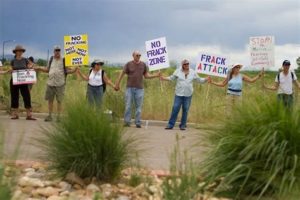About property rights and “takings” in Colorado
Americans have a centuries-long deep and abiding belief in private property rights. Equally dear and vigorously defended is the opposition to government seizure or expropriation of property for all but the most compelling of public uses.
The U.S. Constitution, the Bill of Rights and the 3rd, 4th and 5th Amendments to the Constitution specially address rights to own and defend private property. Some forms of private property ownership have been contentious through the nation’s history. Slave ownership and alcoholic beverages were but two of those, and they resulted in constitutional amendments to settle the issues.
Another private property rights issue is at the forefront of today’s energy up-cycle. The conflict between owners of surface property and owners of mineral rights underlying the surface has been dramatically exacerbated by disinformation fomenting hysteria and the demonizing of hydraulic fracturing. Such “split estate” ownership and the attendant rights of each owner until recently have been negotiated, usually without incident – or at least without public involvement.
The right and ability to own property on the surface and below is at the core of freedom and prosperity typically enjoyed by Americans. By contrast, ownership of the mineral estate in even such advanced societies as Great Britain is by the state, thus stymieing exploration for coalbed methane gas, and late giving rise to the British anti-fracking movement.
When the public has no personal stake in the development of the resource, it perceives no reason for support. The citizenry knows the funds will only feed the insatiable maw of government programs of which there are too many and most too poorly administered and therefore wasteful.
The conflict between the separate owners of the surface and mineral estate plays out quite differently in the U.S. as opposed to Britain. In Britain, voters can (and probably would) vote against elected officials who allow development without compensation of some sort to surface owners – monetary and plus guarantees of remediation for starters.
In the U.S. separate ownership of the two estates has, until recently, has been dealt with by negotiations between the two parties, contractual agreements, rule of state regulators and when no agreement is reached, legal action. Fundamentally, mineral law of the land states when the two estates are separate, the surface owner must accommodate the rights of the mineral owner by providing a “window on the surface for the mineral owner to access his property.
Typically, in oil and gas development, the operator of the well will provide a surface disturbance fee, latitude for the surface owner in road siting, surface well location and maintenance of private roads in adverse weather. And there may be other provisions with considerations of local land use ordinances and zoning.
Of late, the normal and customary course of development has been dramatically opposed, especially in Colorado. Rogue municipalities have seen fit to write their own oil and gas rules, even enacting drilling moratoria in defiance of state law, and even the state Supreme Court. Boulder, Longmont, Erie, Broomfield, Lafayette and some others have attempted to institute their own oil and gas rules.
Statewide, organized and well-funded out-of-state activists have in the three most recent election cycles backed ballot initiatives that would increase setback distances for oil and gas facilities and drilling locations from schools, homes and other occupied buildings. The first of these was backed by hundreds of thousands of dollars in funding by Colorado 2nd District Congressman Jared Polis. He withdrew the proposition reportedly under pressure from national Democrat leadership. He is now running for Governor.

In 2016, a like measure failed to get enough signatures to make the ballot and it appears the effort this year, Initiative 97 with a 2,500-foot setback mandate, is likely to make the ballot. If passed this measure would bar approximately 85 percent of non-federal land in the state from development. In effect, it would shut down the industry in the state.
What about the property rights of the mineral interest owners? Can a minority of a state’s citizens “take” the property rights – the wealth – of mineral interest owners?
The U.S. Constitution is quite clear. The Fourth Amendment bars states from depriving “any person of life, liberty, or property, without due process of law. In the landmark case of Chicago, Burlington and Quincy Railroad Company v. Chicago (1897) the Supreme Court determined that payment of just compensation when private property was taken for public use was an essential element of due process guaranteed by the Fourth Amendment.
Further, in the case of Pennsylvania Coal Co v. Mahon (1922) the Supreme Court broadened the protection of landowners by affirming the takings doctrine. Justice Oliver Wendell Holmes articulated: “The general rule at least is, that while property may be regulated to a certain extent, if regulation goes too far it will be recognized as a taking.”
The PolicySmith apologizes for the protracted legal exposition, but the point needs to be made that property rights are property rights, be they surface or subsurface, conjoined or split. The fact that there are zero demonstrated impacts on drinking water, public health and well-being – and that the economic benefits to local communities and the state are compelling – would be argument enough against the ballot initiative.
At its core, the issue is simply one group of interests taking the property of a rightful owner. The Constitution and Supreme Court decisions through the centuries have made property rights unassailable. Proponents of Initiative 97 are doomed to failure, if not at the ballot box, certainly in the highest court in the land.
Initiative 97 is D.O.A. — R.I.P.



Comment * more learning for me here……….I suppose there is nothing to be done right now in short term re energy development that will address the gas price situation…….but I think the Biden administration needs to take moves that will long term help oil and gas development just as it does alternative energy moves…..but Green forces won’t do it and that is that.
Short term he needs to speed regulatory approval for pipelines to get the crude off the rails and tanker trucks…the two least environmentally friendly transport options. Mostly no one understands that crude and refineries have commonalities. The Gulf Coast refineries are designed to refine heavy crudes such as Venezuela, Mexico and western Canada produce. Eastern refineries are designed for North Sea Brent, Russian, and Bakken crude which is lighter and sweeter (not as much sulfur) than those refined on the Gulf Coast. The Keystone pipe was perfect for heavy crude to be delivered to the Gulf Coast. About 10 percent of it is getting there by rail/tanker truck, the rest is shipped to China. Biden is a captive of the Greens who want no hydrocarbons produced in the US. Nonsense when it is produced globally and less environmentally responsibly than here.